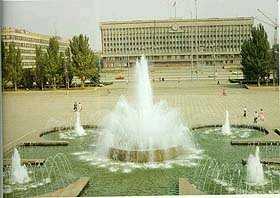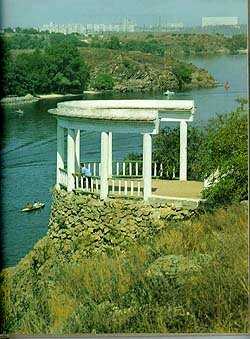Zaporozhye |
The Church in Zaporozhye.
Zaporozhye was opened for missionary work in late 1996. As
of February 2000, there are two branches with about 130 members. (Thanks to Spencer
Willardson for these numbers) The Zaporozhye branches are part of the Dnepropetrovsk
district.
About the City.
Zaporozhye, Pop. about 890,000. Founded in 1770 on the site
of the Zaporozhye Cossack camp, consists of old Zaporozhye (called Aleksandrovsk before
1921 after the commander of the 1st Russian Army, Prince Alexander Golitsyn.) and the new
industrial Zaporozhye, which developed during the 1930s and adjoins the Dneproges
installations and the port of Lenin. It is situated about 600 km southeast of Kiev and
halfway between the fields of iron ore in Krivoi Rog to the West and the coal in the
Donetsk basin to the East. The city is built on the wide plains along both banks of the
Dnepr River.
It is a major rail junction and industrial center and the site of the Dneproges dam and
power station, one of the country's largest hydroelectric plants. Large quantities of
grain are exported. The city has steel mills, coking plants, aluminum and magnesium works,
and factories that produce farm machinery and transformers. One of Ukraine's largest
Chernobyl-type nuclear power plants ensures that Zaporozhye is well supplied with
electricity. Zaporozhye forms, together with the adjoining Donets Basin and the Nikopol
manganese and Krivoy Rog iron mines, one of Ukraine's
leading industrial complexes. As in all other large Soviet cities, the high concentration
of older industry has had a harmful effect on air quality.
and Krivoy Rog iron mines, one of Ukraine's
leading industrial complexes. As in all other large Soviet cities, the high concentration
of older industry has had a harmful effect on air quality.
The island of Khortitsa, (right) in the Dnepr, was headquarters (sich) of the Zaporozhye
Cossacks from the 16th to 18th cent. (The word Zaporozhye means "beyond the
rapids," i.e., of the Dnepr.) For nearly three centuries the Zaporozhye Cossacks
served as the rallying point for Ukrainian struggles against social, national, and
religious oppression.
After the union of Poland and Lithuania in 1569, Ukraine came under Polish rule; but the
Poles were too weak to defend it from frequent devastating Tatar raids. The need for
self-defense led at the end of the 15th cent. to the rise of the Ukrainian Cossacks, who
by the mid-16th cent. had formed a state, organized along republican lines and ruled by a
hetman, along the lower and middle Dnepr. At its height it occupied most of S Ukraine
except the Crimea, a possession of the Crimean Khans. Although they formally recognized
the sovereignty of the Polish kings, the Cossacks, for all practical purposes, enjoyed
complete political independence.